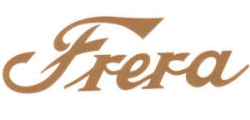


A Brief History of Moto Frera
Corrado Frera was born March 23, 1859 in Kreuznach, Prussia, and was nicknamed, not always affectionately, The German.
His family were of French descent and and had fled to Prussia after the massacre of the Huguenots by Catholics on the night of St. Bartholomew in the late 16th century.
Corrado Frera moved to Italy early in the 1880s and adopted Italian citizenship. It is thought the move from Kreuznach in Alsace Lorraine was due to persecution following the Franco-Prussian war. He married an Italian woman, Sartori, daughter of Carlo e Cristina Lederhasf, and they had four children, two girls and two boys.
Frera had a store in Missori, Milan, selling toys and gift items before entering the bicycle trade and, in 1897, began marketing NSU motorcycles and Zürcher & Lüthi (Zedel) engines. In 1898 they began constructing custom-made motorcycles for keen motorcyclists.
In 1903 a new workshop was established at Tradate in Varese and the first sales of motorcycles commenced. These were built using engines from Zürcher & Lüthi of 1.25 HP, 1.5 HP and 1.75 HP.
In 1906 the factory began producing their own motorcycles under the brand SAF (Società Anonima Frera), still using the Swiss Zedel engine.
In 1907, they displayed an SAF machine with a 1.25 HP NSU engine at the Turin Motor Show, along with two Zedel-powered vetturette (carts?). At this stage the business had already grown quite large, and their beautifully displayed catalogues featuring Frera-Zedel and NSU motorcycles, many bicycles, industrial carts, luxury cars (Phaeton), Omnibuses, and even firearms from BSA including an air rifle.
In 1910 the factory output was 1,200 motorcycles and that figure increased to 3,000 units by 1915 making Frera the most important Italian motorcycle factory. By this time the engines were manufactured in-house, built to the Zedel design under licence.
In 1911 Mario Acerboni won the 1/3 litro (350cc) Italian championship for Frera.
During the 1914-18 war the Tradate factory built thousands of motorcycles and bicycles for the Italian army. The factory had been supplying the military with bicycle ambulances (and possibly motorcycles) since 1908.
After the war the Frera company employed over 600 people, with an annual output growing from 2400 to 3500 (200-300 per month) reaching peak production of 6000 motorcycles annually.
The sustained increase in production encouraged Frera to build a second plant in 1919, located near the railway station in Tradate and named Frera 2, dedicated to assembly and storage of finished machines prior to despatch.
In 1923 some rationalisation was instituted with the number of models reduced and more standardization of mechanical components in order to lower costs whilst boosting production and sales.
By 1925 the factory had over 500 employees and produced 2500 motorcycles annually; 1927 saw production reach more than 5000 motorcycles and in 1928, after more than twenty years of production, the factory announced that a total of 50,000 machines had been constructed.
In 1929 the global economic collapse had grave repercussions on the motorcycle market causing Corrado Frera to consider his options.
Production of a lightweight tractor was considered but eventually rejected. An agreement was signed with the Cemsa for the supply of 300 engines for agricultural machinery, but only 50 units were delivered.
Additionally, a contract with the military for 400 motorcycles to be supplied by Frera, Guzzi and Bianchi fell through.
Discouraged, and being at odds with his partners, Corrado Frera withdrew from the company and a new CEO and head of the sales department were appointed with his son Leonardo Frera as technical director, but the following year Leonardo also left the company; he went on to manufacture his own machine, the Leonardo Frera.
The financial crisis worsened and Frera closed its doors in February 1933. In December 1934, Frera was acquired by a group of industrialists including Paolo Soprani, Sergio Soprani, Umberto Bassani and Andrea Lorenzi.
The new management decided to abandon the construction of bicycles and concentrate everything on motorcycles, building sidevalve 175, 250 and 500cc models. These engines were sold to RAS, Osculati and others. In 1935 the new 4 speed 250cc and 500cc overhead valve high-cam engines were redesigned by the engineer Giuseppe Merosi, but in 1936 Frera finally closed.
Corrado Frera died in Milan on March 20, 1941.
The Frera brand was purchased in 1990 and bicycles of that name were soon being produced. The original Frera factory in Tradate became the Museo Frera which strongly represents Frera alongside many examples of other Italian marques both famous and obscure.
Sources: Moto di Lombardia, Museo Frera, registrostoricocicli.com, Museo da Vinci, et al.
Notes
Mario Columbo rode a factory Frera 500SS 4V.
27-Jan-24
willjarvis at hotmaildotcom
Frera bicycle
Hello, I was wondering if you could be so kind as to provide any information you may have regarding my Frera bicycle. I purchased this bicycle in Indonesia, where I live, with a M55 Cucciolo engine attached. I have attached a few pictures, I am currently restoring this bicycle. Many thanks, kind regards, Will.
Many thanks. I believe my Cucciolo was manufactured circa 1955. My Frera bicycle frame has a brass/bronze Frera head stock badge. This bicycle would not have been originally fitted with a Cucciolo engine, I'm of the opinion that this bicycle frame is pre 1936. Many thanks for posting my message, if you find any information regarding Frera bicycles, please let me know. Kind regards, Will.
Wed Oct 07 2009
nbmoncoll<at>hotmail.com
Frera
Frera 1934 500+cc. SV
Does anyone know of or have one of these? Mine has a wooden sidecar.
I am looking for information or someone who has one and can help me with
matters like timing etc. They were made near MILAN in Tradate, Italy. They
were a large manufacturer and still make bicycles
Wangaratta, Australia